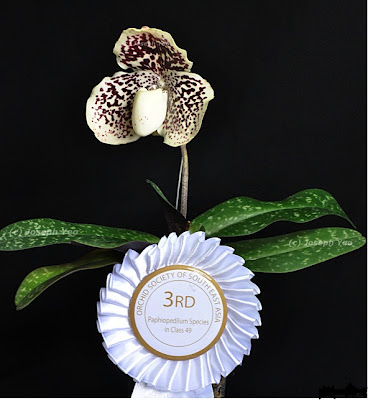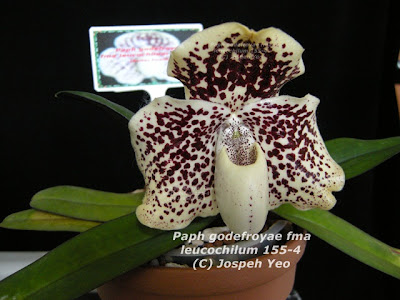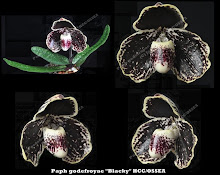Deflasking Paph.
With my success on growing Paphs from flask to flowering, I would like to share my deflasking experience with growers who wish to attempt to grow Paph from flask.
Finally got your hands on a Paph flask? It’s in a bottle. How do I get them out of the flask and flowering in due course?. Help is here to guide you along and hopefully in years (depending on the type of species and hybrids) to come you would reap what you sow
These little babies are fragile and delicate, thus you need to check the bottle to see if they are big enough to be removed. If not, place the flask in a well lit area but out of direct sunlight. Direct sunlight will cook the seedlings.
It is best to remove the seedlings from the flask while they are in the stages of their active growth. Ideally they will be nearly filling the flask, showing no yellowing of the leaves or browning of the leaf tips and have thick furry roots with white tips. Brown basal leaves indicates food has run out and the seedlings are recycling nutrients from the oldest leaves to the growing tip. Overgrown and smaller seedlings will do fine with care, but they may take a little slower to establish themselves.
There is never an "ideal" time to take out the seedlings. They may be a little overgrown before you get them, or if the flask that contains the seedlings may be jumbled up in transit. They may have been contaminated before you received them or your busy schedule may kept you from taking them out. The seedlings should still do fine. They may just take a little more time to adapt and get growing again. If the flask is contaminated with mold (whitish, fuzzy appearance and generally covering the roots) or with a bacteria (slimy appearance covering the agar) that spreads quickly across the surface, the seedlings should be removed. Under these conditions the seedlings may not progress further, and may actually be killed very quickly. If you are lucky the contamination might only be caused by a bacteria that can only grow where there is excess moisture on the surface, usually along the walls of the flask. In this case, you can usually let the flask grow on, but it has to be watched carefully.
Between Polycarbonates (take away food container) and a glass flask, polycarbonate have the advantage of allowing a significantly larger growing area, allowing light to pass through from the top, and is easy to deflask without having to destroy the flask. However, it takes up a significantly larger space.
Getting the Seedlings Out.If you are dealing with a glass container with a narrow opening (whiskey bottle or conical flask), it is best that you resist the temptation of trying to ease the seedlings out through the narrow opening. This may cause damage, even if it is not immediately apparent so instead break the bottle.
An optional step would be to remove the flask cover and allow the flask to aerate for a day. This enables the flasked plants to acclimatize with the external environment. In our hot and humid environment, the agar medium may be more susceptible to contamination when the cover is opened for too long.
Line your work surface with layers of newspaper to catch debris from the flask and also to facilitate the ease of cleaning. Extra newspaper may be required to wrap up the broken flask. Wrap the flask tightly in the extra sheets of newspaper and hold the ends firmly with one hand. You can either use pair of pliers or a hammer to knock the bottom or the side of the flask. Some flasks are specially designed to have a bottom rim that is thinner than the rest of the flask to aid removal through this method.
Some growers use a "drift", which is like a large metal rod or punch. You can make one out of a large bolt if you cannot find one, but you should be able to get one, or something similar at a hardware store. The drift needs to be longer than the height of the flask. Wrap the flask in newspaper several layers thick, keeping the opening clear. Carefully push the drift down through the root and agar mass near the center of the flask until it comes into contact with the glass, and give the drift a tap with a hammer.
When a clean crackling sound is heard, the flask would have broken sufficiently. This demonstrates a clean break where the top of the flask separates nicely from the bottom rim. Be mindful of fine glass chips. You can use a pair of forceps or tweezers to remove the glass from the seedlings and agar. This is to avert personal injury months later when you repot,
Washing and Soaking.Put some water (at room temperature) into the flask and gently shake the flask to loosen the agar off the plant roots. You can use a long tooth pick (satay stick) to pry off the stubborn and larger chunks of agar- especially the large sections around the edges.
Different plants have different root types, ranging from the very wiry roots of some multiflorals which come off from the agar very easily. Whereas the fleshy, hairy brittle roots of brachys might cling to the agar tenaciously. If the roots are seriously intertwined, do not use force to separate them. You could easily break the fragile roots and damage the plant. They will be easier to separate after they are ready to come out of compot. At this stage, too much agar promotes excess fungus growth which can cause rotting in the plants and perhaps rot the roots.
Remove as much dead plant parts where possible. This is to reduce the chances of fungal or bacterial growth on the dead plant parts.
It is not necessary to use a nutrient, fungicidal or disinfectant soak at this time if the seedlings came from an uncontaminated flask and are in good shape. However, some growers would advocate the use of fungicide soak. If you need to use them, use it very sparingly, or you may run into the risk of burning the tender seedlings. When they are out of the flask, they have very little cuticle on them. It would be prudent to wait a few days and spray the compot with the disinfectant. At any rate, if you have a method that works well for you, stick with it. Discard any damaged, deformed or proliferated seedlings, it does not pay to waste space on them.
Containers and MediumPrepare your work area with a sheet of clean newspaper on the work space. Ensure the pot is clean, and the potting media is sterile. A mixture of fine fern bark chips, diatomite, pumice, perlite and fine Leca can be used for seedlings. You can sterilize them by heating them in a microwave oven for 10 minutes.
Disposable plastic cup and Potting Mix Crocked pot before planting.
Place the seedlings on a clean sheet of newspaper and allow them to air dry. Fill up to 1/3 of the height of the pot with crocking material. It is not ideal to fill the pot with the potting medium as some plants are particularly fussy above having their roots or root junctions too wet. The potting mix use should be able to anchor the plants securely, preventing wobbling and yet allow for free draining of the irrigation water. The potting mix should be able to somewhat dry out within 2 to 3 days.
Fill up 1/2 of the pot with the potting mix or to a height that would accommodate the root length of the seedlings. Drip dry the seedlings and place them on top of the potting mix. You may wish to place several seedlings within the same pot if the seedlings are too small to be potted by themselves. Top up the pot with potting mix and gently press down or tap the pot to compact the potting mix. This is to allow the new roots to anchor firmly. If the potting mix is too loose, the plants may dislodge from the pot during watering. On the contrary, a packed mix does not allow the mix to drain freely. At times it may be too difficult to separate the seedlings. In such a situation, keeping the seedlings in a compot (community pot) would be a better choice.
There are a vast number of possible for containers which you can use to grow your seedlings. The key is to match the pot and your growing mix to your growing conditions. Particularly this with regards to temperature, humidity and air movement as these factors will affect the speed at which your pot/compot dries out.
Planting.
First, resist the temptation to segregate and pot out the bigger seedlings individually. Seedlings fresh from the flask do not yet have the tough cuticle that an adult plant has developed. All seedlings will appreciate the nurturing microclimate provided by the compot approach.
A group of the plants of approximately equal size is gathered together and aligned as much as possible, so that the root-plant junction is at the same height for all. A little mix is put in the bottom of the pot, and the plant clump is held in the center while the mix is placed and packed evenly around them. The mix should be packed firmly.
Post Planting CareMost seedlings die from Too Much Water. Mist the leaves lightly over the next few days. Frequent light misting will prevent dehydration and encourage new root growth without keeping the media too wet.
It is very important to keep freshly deflasked seedlings in very subdued light of no more than 800 foot candles. They should be grown in flasks under similar lighting conditions, and the transition to higher levels should be made gradually over several weeks, or you will risk stunting or even killing the seedlings.
Compots are fed weakly but steadily. They are allowed to approach dryness but for the first couple of weeks, fungicides should not be used on the seedlings, as a growth inhibiting effect can be caused by fungicides. If there is a problem with fungus or mould, this means the conditions are too wet, so reduce watering , ensure ventilation is sufficient, and let the seedlings dry out a bit. In fact, most fungus problems that occur in growing seedlings can be fixed by reducing water and increasing ventilation.
Within seven to ten days of post planting you can apply a spray of fungicide. It is best to try to keep the seedlings quite warm through this early period, probably 25 to 28 C would be ideal.
Once the seedlings are established and grown to their second lead or new larger leaf, they can be potted singly into small pots. You can plant several seedlings in a pot and when they flower, it will become a showy specimen display.
It is necessary not to let a lot of water in the crowns of the plants as water might not dry out before the plant lights go off in the evening. All you have to do is give a good watering around the edges, keeping the compot tilted so that water goes to the center.
 Paph godefroyae fma leucochilum MK436-11:
Paph godefroyae fma leucochilum MK436-11:
















































